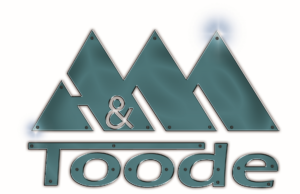For safe performance of roof maintenance works, an optimal complete solution should be worked out with the assistance of a master roofer. Requirements established by standards should not be forgotten either. What is really important?

Estonian standard EVS 812-3:2018, Regulation “Fire Safety Requirements to Buildings and Requirements to Fire Water Supply” of the Government or the Republic, and the Fire Safety Act require:
– Installation of a fixed ladder on all roofs from inclination 11°(approx. 1:5).
– In case of buildings higher than 8.5m, access to the roof must be provided through the attic and/or roof hatch or using a fixed (stationary) external emergency ladder.
– To a chimney higher than 1.2m from the roof surface, a cleaning platform with the necessary access ladder must be installed.
What does “fixed” mean? There are wooden ladders of dubious strength and stability on the roofs of many older buildings. Furthermore, to a new tin roof, the ladder should be fixed firmly, to avoid surface coating damages caused by a movable wooden or aluminium ladder. Ask the roofer to determine the best locations for ladders and walkways ensuring convenience, efficiency, and safety of use. The house owner’s habits (for example, heating-related), vandalism resistance (a ladder should not be installed onto a wall facing the street), and visual appearance should be considered.
It is important to comply with requirements to walkway and ladder roof installation. Several standards apply to walkways and ladders used on the roofs, which establish the requirements to fasteners. The manufacturers’ installation instructions specify the maximum allowed spacing of the fasteners.
Recommendations on correct installation of safety accessories
– The placement of safety accessories must comply with a well-considered, optimal and logical complete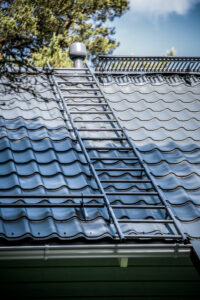 solution.
solution.
– In case of roofing penetrated by screws, the fasteners of safety accessories must coincide with the battens. In case of Class2 installation, the outermost fasteners must coincide with end rafters.
– The fasteners may not damage the roofing underlay membrane, except at the crossing of the rafter, spacer, and batten.
– In case of rolled metal roofs and Classic-type roofing materials, at the area of safety products attachment, the spacing of roofing fasteners to the battens must be shortened. In case of snow guards and bridges, it is important for the sheet metal panel located under the upper part of their attachment supports to be fastened to the batten at the same location. At such areas, the “lifting” resulting from loads is the greatest, and in case of inadequate fastening, the panel could be torn up with the snow guard or bridge fastener.
– In case of rolled metal roofs and Classic-type roofing, no penetrating holes (screw holes) in the roofing resulting from safety product attachment are allowed.
– If possible, roof and wall ladder attachment to chimneys should be avoided. There are other products available for this purpose.
– When planning the placement of safety accessories, if possible, it should be made sure that snow accumulating behind them does not cause excessive local snow loads or potential leaks resulting therefrom (e.g., at the valleys and other elements of profiled and low-pitched roofs).
– Never use safety accessories for purposes other than intended. For example, pipe-style snow guards as ladders or safety rails. Round pipes rotate in their holders and do not make for safe footing, etc.
– When installing safety ropes and rails on bridges or ladders, the specifications and requirements of
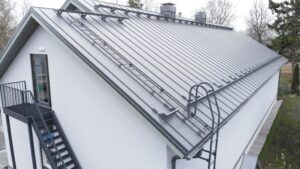
Class1 and Class2 must be complied with.
– In case of very low inclinations, installation of a roof ladder is altogether pointless. It is impossible to walk on them safely. In case of low inclinations, roof bridges must be preferred or step plates installed on ladders used. Bridges are never installed along the panel, only crosswise. When using a ladder on a low-pitched roof, installation of plates for safe walking on the ladder rungs is recommended.
– The bottommost rung of a wall ladder must not be accessible to children.
– In case of high wall ladders, the need for a safety cage should be considered.
– In case of production and public buildings, the wall ladder frame width exceeds that of residential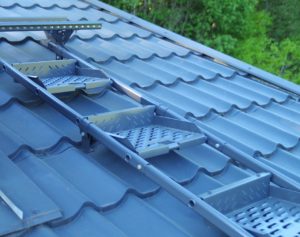 buildings.
buildings.
– The fasteners used with safety accessories (screws, bolts, nuts, seals) are special products tested for the loads associated with safety accessories, not general-purpose products purchased from a hardware store.
– The fasteners must be suitable for outdoor use.
– Snow guard placement must consider the resulting changes in load and its possible influence on the stability of the building.
– When determining the need for snow guards, proceed from the principle: As many as necessary, as few as possible.
It is important to check the tightness of safety product fasteners regularly. We recommend entrusting this job to a master roofer. The situation is somewhat the same as in case of requirements to periodical heating equipment inspection.
– If the spacing of fastening solutions is increased, proper functioning of the products need not be ensured; always comply with the manufacturer’s installation instructions. These are usually drawn up based on the material properties and test results.
– When installing a roof ladder, the first ladder rung should be vertically aligned with the eaves or edge of roofing, so that a ladder mounted could be supported against the first rung of the stationary roof ladder. This avoids damaging the eaves or roofing edge by the temporary ladder.
– Do not split the products with abrasive cutting discs; use a hacksaw.
– Damaged products must be replaced with new ones.
– If possible, avoid using sheet metal snow guards. A sheet metal snow guard is very efficient as a snow barrier and may thus be subject to much greater loads as compared to pipe-style snow guards, especially in case of wet snow. As a consequence, the sheet metal snow guard may be deformed or torn out of the batten with the support element. The resulting hole in the roofing is impossible to patch in a waterproof manner.
– The seller of safety products must submit the required certificates and product information. Require them already in the request for quotation stage.
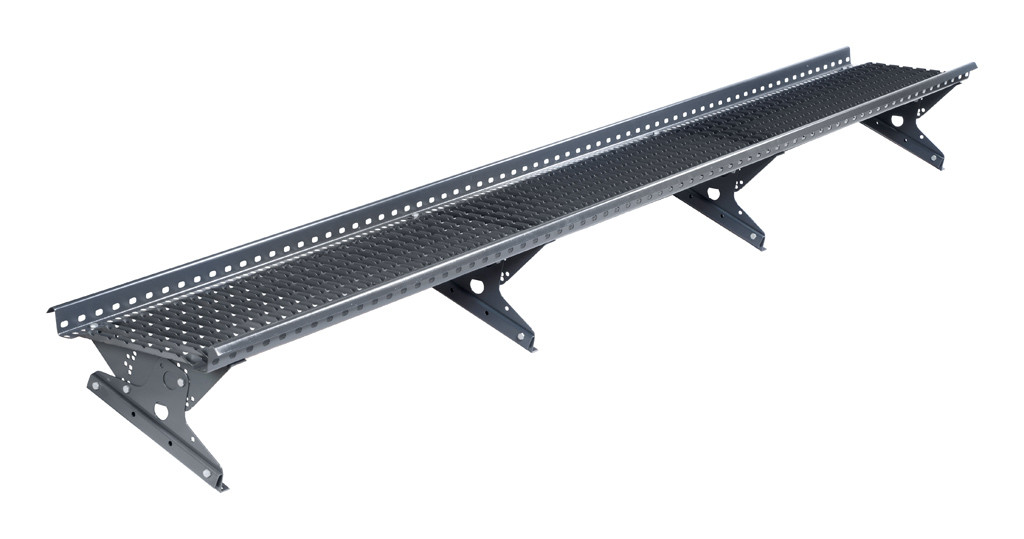
Annual inspection of safety accessories must include:
– Inspection of the tightness of element joints.
– Inspection of the attachment of roof bridge and ladder sets to the roof or roofing (variations are possible depending on the roofing).
– At locations subject to regular increased snow load, the inspections must be carried out more often, as required, but not less frequently than once a year.
– In case of excessive snow and ice load, roof bridges and ladders must be cleaned regularly.
– Inspect the condition of the surface coating of products (paint or zinc coating, in case of galvanized products). If necessary, use touch up paint to repair the damages or replace the products.
– Products damaged mechanically or otherwise must be repaired or replaced.
